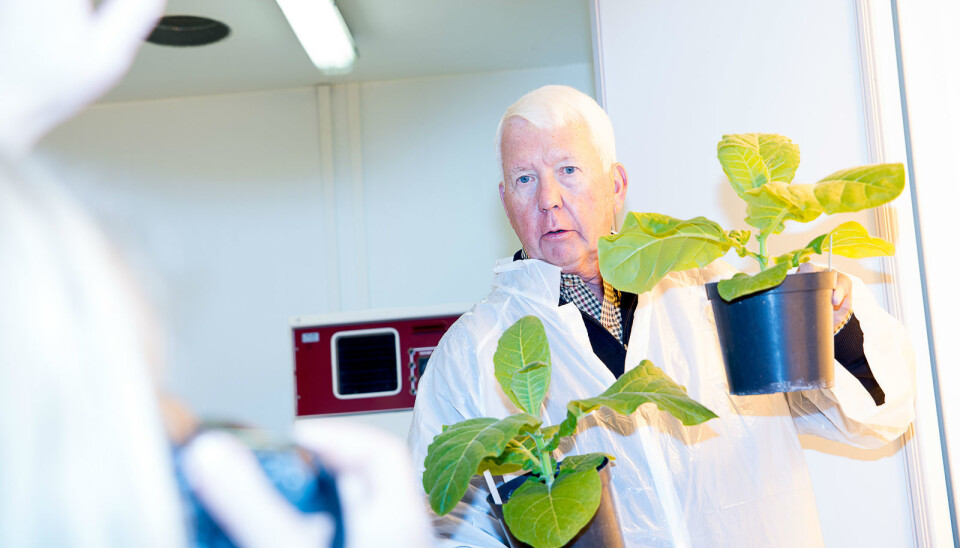This article was produced and financed by Norwegian Institute for Agricultural and Environmental Research

From genetically modified tobacco plants to medicine for Ebola
A commitment to global health and out-of-the box thinking prompted Professor Charles Arntzen to develop a medicine for Ebola from genetically modified tobacco plants.
It was his belief in plant based vaccines and his dedication to overcome health and agricultural constraints in the developing world that made Charles Arntzen, professor at the Arizona State University and a pioneer in the development of plant-based vaccines, genetically modify tobacco plants to produce the recombinant protein based Ebola medicine ZMapp in tobacco.
Last week, the Norwegian Biotechnology Advisory Board invited Charles Arntzen to Norway to talk about his work in Ås, Oslo, Bergen and Trondheim.
Only for the rich
One of the main problems with the vaccines we have today is that millions never receive them. The current vaccination programs work fine in rich countries with good health care, where diseases such as measles, smallpox, and polio have been eradicated. However, these vaccines have to be kept cold, require sterile needles and qualified medical care. The majority of conventional vaccines are also expensive to develop, requiring a large amount of up front capital, and are very time consuming to produce; the process from discovery to licensing a new antibody usually takes 12-15 years.
For more than two decades, professor Arntzen has been looking into how we could transfer modern technology for drugs into the developing world, as by and large they are currently not penetrating. He believed edible plant vaccines could be the answer.
There are a whole variety of excellent systems used to produce antibodies, such as eggs for the flu vaccine and yeast for Hepatites B. This made him think: “why not plants”?
And in 1992 Arntzen showed that tobacco plants could be used for this purpose.
Perception issue
But from 1992-2000, Arntzen was involved in “endless meetings” with big vaccine companies, without gaining any interest. “They had no corporate interest or experience with biotechnology. Particularly European companies were scared of GMO,” he explains and adds: “GMO perception issues clouded the picture.”
In the US, research is driven by the tax payers, which means it is focused on mainstream diseases. But the US military put soldiers on the front line in different parts of the word, and therefore finances research into emerging diseases found in these regions.
After September 11 and an anthrax scare in 2001 however, the US saw that terrorism could also affect home. The threat of bio-terrorism led to an increase in the research budget.
This included major funding for Arntzen and his collaborative partners to work on an ebola antibody using tobacco plants.
Ebola antibodies
To produce therapeutic proteins inside a tobacco plant, genes for the desired antibodies are fused to genes for a natural tobacco virus. The tobacco plants are then infected with the artificial virus, producing the antibodies. Then plants are ground up and the antibodies extracted.
In 2005, the first report came which showed that the ebola virus antibodies could be produced. The antibodies have since been tested on mice and monkeys. This summer it was also used to treat two Ebola-infected American health workers. They both recovered from the virus. This was groundbreaking in many ways. It was for example not normally allowed to use medicine which had not gone through all the clinical tests. This could lead to a change in protocol in the future, suggests Arntzen, who believes medicines need to get out as quickly as possible in these kinds of situations.
Many challenges
However, ZMapp is difficult to make in large quantities for a number of reasons, Arntzen says. It involves three antibodies, which triples the amount of tobacco plants needed. In addition, the dose used to treat patients is high compared with many drugs, increasing the needed supply.
For now, production has been limited to a handful of doses. That’s far too few to have an impact on the current outbreak in West Africa. He predicts 1000 doses could be produced by the end of the year, and says 1 million could perhaps be possible by the end of next year.
The professor says the situation poses many important questions that need answers:
“Who is going to scale it up? Who is going to get the medicine?” he says and adds that it will be fascinating to watch how it will be solved.
Meanwhile, tobacco plants are also being used to make other antibodies. In Norway, researchers at Bioforsk - the Norwegian Institute for Agricultural and Environmental Research - are using the same technology to develop life saving vaccines against Dengue fever.






























